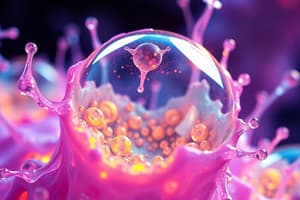Podcast
Questions and Answers
Which type of microscopy uses UV light and fluorescent substances to emit visible light from the specimen?
Which type of microscopy uses UV light and fluorescent substances to emit visible light from the specimen?
- Electron Microscopy
- Transmission Electron Microscopy
- Scanning Acoustic Microscopy
- Fluorescence Microscopy (correct)
What does Differential Interference Contrast (DIC) Microscopy use to split light beams, providing more contrast and color to the specimen?
What does Differential Interference Contrast (DIC) Microscopy use to split light beams, providing more contrast and color to the specimen?
- Magnetic Fields
- Electron Beams
- Acoustic Waves
- Prisms (correct)
What type of microscopy uses a special condenser with an opaque disk that eliminates all light in the center of the beam?
What type of microscopy uses a special condenser with an opaque disk that eliminates all light in the center of the beam?
- Darkfield Microscopy (correct)
- Electron Microscopy
- Transmission Electron Microscopy
- Scanning Acoustic Microscopy
In Confocal Microscopy, what is used to excite a single plane of a specimen?
In Confocal Microscopy, what is used to excite a single plane of a specimen?
Which type of microscopy allows examination of layers of cells up to a depth of 100 μm?
Which type of microscopy allows examination of layers of cells up to a depth of 100 μm?
What type of microscopy allows examination of living organisms and internal cell structures by bringing together two sets of light rays?
What type of microscopy allows examination of living organisms and internal cell structures by bringing together two sets of light rays?
In which microscopy technique do only light reflected off the specimen enter the objective lens?
In which microscopy technique do only light reflected off the specimen enter the objective lens?
Which technique shows greater differentiation of internal structures and clearly shows the pellicle?
Which technique shows greater differentiation of internal structures and clearly shows the pellicle?
Which microscopy technique produces an image where edges of cells are bright against a dark background?
Which microscopy technique produces an image where edges of cells are bright against a dark background?
Which microscopy technique uses two light beams and prisms?
Which microscopy technique uses two light beams and prisms?
In which type of microscopy are some internal cell structures seen to sparkle and the pellicle almost visible?
In which type of microscopy are some internal cell structures seen to sparkle and the pellicle almost visible?
Which microscopy technique combines direct light rays with light rays that are reflected or diffracted as they pass through the specimen?
Which microscopy technique combines direct light rays with light rays that are reflected or diffracted as they pass through the specimen?
In which microscopy technique are dark objects visible against a bright background?
In which microscopy technique are dark objects visible against a bright background?
When light is reflected off the specimen and does not enter the objective lens, which type of microscopy is being used?
When light is reflected off the specimen and does not enter the objective lens, which type of microscopy is being used?
Which type of microscopy uses sound waves to produce images of specimens?
Which type of microscopy uses sound waves to produce images of specimens?
What is a key difference between electron microscopy and light microscopy?
What is a key difference between electron microscopy and light microscopy?
Which type of microscopy allows internal structures and outlines of transparent samples to be visible?
Which type of microscopy allows internal structures and outlines of transparent samples to be visible?
Which type of microscope is best suited for observing fine internal structures of cells and tissues with high resolution?
Which type of microscope is best suited for observing fine internal structures of cells and tissues with high resolution?
Which type of microscopy uses electrons to produce an image?
Which type of microscopy uses electrons to produce an image?
In Transmission Electron Microscopy, what is used to focus the electron beam onto the specimen?
In Transmission Electron Microscopy, what is used to focus the electron beam onto the specimen?
What is a key characteristic that distinguishes Scanning Electron Microscopy from Transmission Electron Microscopy?
What is a key characteristic that distinguishes Scanning Electron Microscopy from Transmission Electron Microscopy?
Which type of microscopy technique uses UV light to excite fluorescent substances in cells?
Which type of microscopy technique uses UV light to excite fluorescent substances in cells?
What is a primary advantage of Fluorescence Microscopy over Electron Microscopy?
What is a primary advantage of Fluorescence Microscopy over Electron Microscopy?
Which feature distinguishes Fluorescence Microscopy from other types of microscopy discussed in the text?
Which feature distinguishes Fluorescence Microscopy from other types of microscopy discussed in the text?
What type of microscope uses secondary electrons emitted from the specimen to produce a three-dimensional image?
What type of microscope uses secondary electrons emitted from the specimen to produce a three-dimensional image?
Which type of microscope magnifies objects between 1,000 to 500,000 times with a resolution of 10 nm?
Which type of microscope magnifies objects between 1,000 to 500,000 times with a resolution of 10 nm?
Why do electron microscopes have greater resolution than light microscopes?
Why do electron microscopes have greater resolution than light microscopes?
Which microscopy technique produces a three-dimensional appearance of cells in contrast to the two-dimensional appearance of transmission electron micrographs?
Which microscopy technique produces a three-dimensional appearance of cells in contrast to the two-dimensional appearance of transmission electron micrographs?
What is a key difference between electron microscopy and fluorescence microscopy?
What is a key difference between electron microscopy and fluorescence microscopy?
Which type of microscope uses an electron gun to produce a beam of electrons that scans the surface of a specimen?
Which type of microscope uses an electron gun to produce a beam of electrons that scans the surface of a specimen?
What type of microscopy uses electrons instead of light to image objects too small to be seen with light microscopes?
What type of microscopy uses electrons instead of light to image objects too small to be seen with light microscopes?
How does Transmission Electron Microscopy differ from Scanning Electron Microscopy?
How does Transmission Electron Microscopy differ from Scanning Electron Microscopy?
Which component is used to focus the image in a Transmission Electron Microscope?
Which component is used to focus the image in a Transmission Electron Microscope?
What is a characteristic feature of Fluorescence Microscopy that distinguishes it from Electron Microscopy?
What is a characteristic feature of Fluorescence Microscopy that distinguishes it from Electron Microscopy?
In what way do Electron Microscopy and Fluorescence Microscopy significantly differ?
In what way do Electron Microscopy and Fluorescence Microscopy significantly differ?
How does the resolution of Scanning Electron Microscopy compare to Fluorescence Microscopy?
How does the resolution of Scanning Electron Microscopy compare to Fluorescence Microscopy?
Flashcards are hidden until you start studying
Study Notes
Microscopy Techniques Overview
- Fluorescence Microscopy: Utilizes UV light and fluorescent substances to emit visible light from the specimen.
- Differential Interference Contrast (DIC) Microscopy: Employs prisms to split light beams, enhancing contrast and color of the specimen.
- Dark Field Microscopy: Utilizes a special condenser with an opaque disk to eliminate light in the center, highlighting specimen edges.
- Confocal Microscopy: Uses a focused laser to excite a single plane of a specimen for detailed imaging.
- Depth Examination: Certain types of microscopy allow observation of layers of cells up to 100 μm deep.
- Phase-Contrast Microscopy: Enables examination of living organisms and internal structures by unifying two sets of light rays.
- Reflection Microscopy: Only light reflected off the specimen enters the objective lens, enhancing surface feature visibility.
- Pellicle Clarity: Techniques in microscopy can show greater differentiation of internal structures, clearly illustrating the pellicle.
- Bright Field Microscopy: Produces images where cell edges are bright against a darker background.
- Two-Beam Microscopy: Employs two light beams and prisms for creating detailed specimen images.
- Internal Structure Sparkle: Certain microscopy techniques can reveal internal cell structures that sparkle, nearly exposing the pellicle.
- Combined Light Rays: Techniques that combine direct light with reflected or diffracted rays enhance specimen visualization.
- Dark-Field Microscopy: Identifies dark objects visible against a bright background.
- Reflected Light Microscopy: Identifies circumstantial features by reflecting light off the specimen without entering the objective lens.
- Ultrasound Microscopy: Utilizes sound waves to generate images of specimens.
Electron Microscopy Characteristics
- Light vs. Electron Microscopy: Electron microscopy uses electrons to produce high-resolution images, whereas light microscopy relies on visible light.
- Visibility of Transparent Samples: Certain microscopy allows the visualization of internal structures and outlines of transparent specimens.
- High-Resolution Observation: Electron microscopy is particularly suited for observing fine internal structures of cells and tissues.
- Transmission Electron Microscopy (TEM): Focuses the electron beam onto the specimen to produce detailed images.
- Scanning Electron Microscopy (SEM): Achieves three-dimensional imaging by scanning the surface with electrons.
- Key Differentiators: SEM provides a three-dimensional appearance of cells compared to the two-dimensional views from TEM.
Special Features and Advantages
- Fluorescence Microscopy Advantages: Offers the ability to visualize specific structures and processes using fluorescence over the capabilities of electron microscopy.
- Secondary Electrons in SEM: Generates three-dimensional images using secondary electrons emitted from the specimen.
- Magnification and Resolution: Certain microscopes can magnify objects between 1,000 to 500,000 times with a resolution of 10 nm.
- Resolution Differences: Electron microscopes achieve greater resolution than light microscopes due to smaller wavelength applications.
- Three-Dimensional Imaging of Cells: Certain techniques provide a three-dimensional appearance, crucial for understanding cellular structures.
Comparative Analysis
- Electron vs. Fluorescence Microscopy: Electron microscopy focuses on structure, while fluorescence highlights specific molecular interactions.
- SEM vs. TEM: SEM scans a specimen’s surface while TEM transmits electrons through a specimen for internal structure imaging.
- Components in Microscopy: Transmission Electron Microscope uses magnetic lenses to focus the electron image accurately.
- Significant Differences: Electron microscopy and fluorescence microscopy significantly differ in imaging methods and resolution capabilities.
Studying That Suits You
Use AI to generate personalized quizzes and flashcards to suit your learning preferences.




